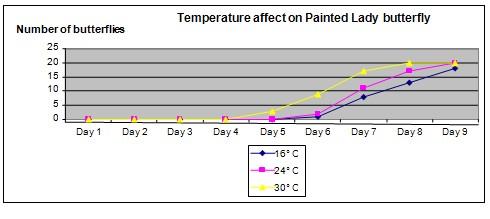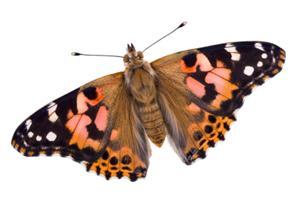| Complexity level: | 3 |
| Project cost ($): | 30 |
| Time required: | 1 day to prepare, 9 days for the science project experiment |
| Material availability: | Easily found |
| Safety concerns: | NA |
Hypothesis
The metamorphosis of the Painted Lady butterfly occur more quickly at higher temperatures.
Overview
The lifecycle of a butterfly
Butterflies are beautiful colorful insects that can be found almost anywhere. There are over 15,000 species of butterflies found all over the world. They feed on nectar from flowers using their hollow straw-like tongues that recoil.
The life cycle of a butterfly consists of 4 stages. The adult female butterfly will lay eggs on plants that caterpillars like to eat. The eggs may take from 3 to 5 days to hatch. The hungry caterpillars will then begin eating the leaves continuously and grow very quickly. As they continue growing the caterpillars will shed and grow new skin at least 3 to 4 times - and they can grow up to 5 cm in less than 2 weeks.
Once fully grown, the caterpillar will find a safe spot, form a silk pad and suspend itself from the pad. The skin of the caterpillar will tear open and a hard shell-like surface called the chrysalis is revealed. For the next 7 to 9 days, the caterpillar will transform into a butterfly inside the chrysalis. Once the transformation is complete, the butterfly will struggle out of the chrysalis. It will take a few hours before the butterfly is able to start flying. Butterflies are able to live for up to 2 weeks. Their lifespan is indeed short.
Scientific Terms
Materials
The materials required for this science fair project:
- 3 transparent fish tanks
- 60 Painted Lady butterfly caterpillars
- 3 leafy plants that can be placed in the fish tank
- 1 air conditioned room
- 1 incandescent lamp
- 3 thermometers
Procedure
1. For this science fair project, the independent variable is the temperature that the caterpillars are exposed to during the chrysalis stage. The dependent variable is the number of days it takes for the transformation from the beginning of the chrysalis stage until the butterfly emerge. This is determined by observing and counting the chrysalis in the tank everyday. The constants (control variables) are the number of butterflies, the species of butterflies used, the type of leaves the caterpillars are fed and the size of the fish tank.
2. The 3 fish tanks are labeled A, B and C. One leafy potted plant is placed in each fish tank. Twenty Painted Lady butterfly caterpillars are placed on the plants in each tank.
3. The 3 tanks are kept under the following conditions.
a. Tank A –an air conditioned room where the temperature is maintained at 18° C,
b. Tank B –at normal room conditions with temperature around 24° C ,
c. Tank C –under an incandescent lamp with an average temperature at 30° C
4. Not all caterpillars will move on to the chrysalis stage on the same day. You'll need to carefully observe all of the caterpillars individually to ascertain which ones have begun to transformr. The number of days the caterpillars take to transform from the beginning of the chrysalis into a butterfly is observed and recorded.

Results
The Painted Lady butterflies that were placed under the incandescent lamp at 30° C were the fastest to complete the transformation followed by the butterflies in the tank under normal room conditions.
|
Tank temperature |
Number of days taken for transformation from chrysalis to butterfly |
||||||||
|
Day 1 |
Day 2 |
Day 3 |
Day 4 |
Day 5 |
Day 6 |
Day 7 |
Day 8 |
Day 9 |
|
|
16° C |
0 |
0 |
0 |
0 |
0 |
1 |
8 |
13 |
18 |
|
24° C |
0 |
0 |
0 |
0 |
0 |
2 |
11 |
17 |
20 |
|
30° C |
0 |
0 |
0 |
0 |
3 |
9 |
17 |
20 |
20 |
|
The graph below represents the results of our science project experiment.

Conclusion
The hypothesis that the metamorphosis of the Painted Lady butterfly will occur more quickly at higher temperatures, is proven to be true.
Metamorphosis is a natural occurrence in insects - it is an intermediate stage as they transform from a larvae into an fully grown insect. Similar transformations can also be seen in amphibians such as frogs, as they transform from an egg to a tadpole and finally into an adult frog.
Also consider
What would happen if the science fair project were to be repeated by placing the butterfly chrysalis inside a copper coil with magnetic fields?
The science fair project can also be repeated with mealworms, to observe the metamorphosis of beetles.
References
Life cycles of the painted lady butterfly - http://mypages.iit.edu/~smart/pearkat/lesson1.htm
Metamorphosis - http://en.wikipedia.org/wiki/Metamorphosis

